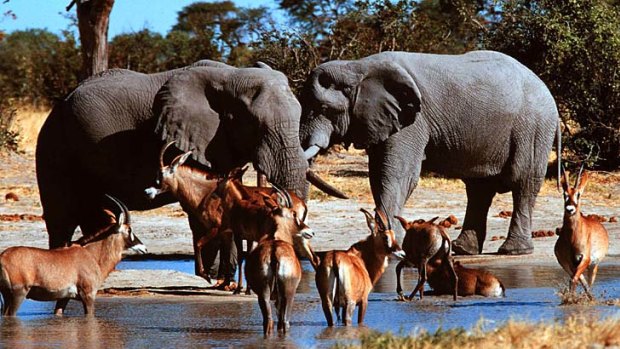
Beauty and beasts ... animal numbers in the Okavango Delta, Botswana, are declining.Credit: AP
'Unexpected' results show the catastrophic effect of drought and poachers on Africa's wildlife, writes David Smith.
The Okavango Delta in Botswana has suffered "catastrophic" species loss during the past 15 years, researchers have announced in the latest sign of a growing crisis for wildlife in Africa.
Some wild-animal populations in the delta have shrunk by up to 90 per cent and are facing local extinction, according to the most comprehensive aerial survey undertaken there.
The findings come after a study this month showed dramatic declines in animal numbers in the Masai Mara wildlife reserve in south-western Kenya, raising anxiety about the effectiveness of conservation across the continent.
The delta, in northern Botswana, has about 50,000 islands among a series of channels, lagoons and swamps that reach the Kalahari Desert. Travellers pay premium rates to stay in upmarket safari lodges, many accessible only by air, and for the chance to explore the pristine 16,000-square-kilometre oasis.
Botswana has been careful to restrict visitor numbers and preserve the fecundity of this watery wilderness. But research shows some of the delta's most precious assets will be jeopardised unless urgent action is taken.
"The results were unexpected," says Mike Chase, the founder of Elephants without Borders, which did the aerial survey of the region. "There has been a cosy pretence that wildlife is thriving and doing well in the Okavango Delta. Our survey provides the first scientific evidence that wildlife is declining, and pretty sharply, too."
Chase's study found 11 species declined by 61 per cent since a 1996 survey in Ngamiland district, the location of the delta. Ostrich numbers were worst hit with a 95 per cent drop, from 11,893 animals to 497 last year. About 90 per cent of wildebeest have also been wiped out, along with 84 per cent of tsessebe antelope.
Chase says a drought in the 1980s and 1990s plus bushfire, habitat encroachment and poaching are the main reasons for the nosedive. "The causes are multiple and complex but drought is the overarching one," he says.
Poaching also has had a big impact, Chase says.
Not all species experienced decline. Hippos increased, at 6 per cent a year, and the world's biggest elephant population appears stable, with about 130,000 animals.
"Wildlife is dynamic and, with a little help from fantastic conditions, anti-poaching measures and some government assistance, it will rebound," Chase says.
Some have warned against panic. Richard Fynn, of the Okavango Research Institute at Botswana University, says: "We cannot be sure what the population levels were in the past and we need to do more detailed research.
"Yes, there are declines in certain species such as tsessebe but I think we'll see a big increase in species such as zebra. To make it out as a catastrophe would be unhelpful."
The Okavango Delta is not the only tourist destination in Africa to face a loss of natural bounty. Researchers have found that in Kenya's Masai Mara, numbers of impala, warthog, giraffe, topi and Coke's hartebeest have declined by more than 70 per cent in three decades.
- Guardian News & Media
Sign up for the Traveller Deals newsletter
Get exclusive travel deals delivered straight to your inbox. Sign up now.